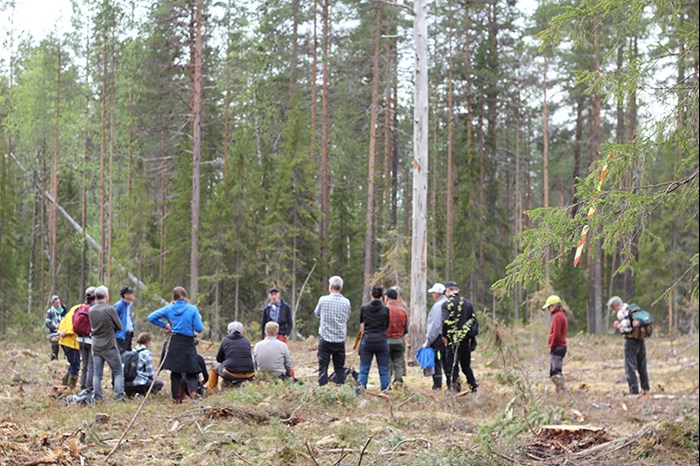- You combine practical aspects such as talking to local forest stakeholders with machine learning and modelling approaches in your thesis. What was the benefit of combining such different approaches?
First of all, I think it is fun to test new techniques, try new things and new ways of research. For one part of my thesis, we used the Heureka system, that has been developed at SLU. We quantitatively evaluated different forest scenarios by modelling them over a 100-year period. In the next step, we analysed the different scenarios qualitatively in a workshop together with the stakeholders.
It was so interesting to see that the stakeholder brought forward totally different things than came out from the modelling. They were discussing for example the possible outcome of a scenario on the local level, what kind of conflicts it would create between different types of stakeholders and if it would be socially accepted. These aspects were not captured by our models, but it will be very important to implement them in the management planning. Combining these two types of evaluation side-by-side, the quantitative modelling approach and the qualitative one, was therefore a big benefit.
- Did anything unexpected came out during your analyses?
For me that avenue to use machine learning was very unexpected, more unexpected than the results itself. We wanted to analyse what type of forest related conflicts are being discussed in the media. There were already analyses of specific conflicts available, mostly analysing what different stakeholders have said. However, we wanted to get a broad overview and understand how big the conflicts are in relation to each other.
To read everything myself and sort it manually would have taken too much time but then we end up using topic modelling. This machine learning approach originates from computer sciences but is now used also in bioinformatics, social sciences and humanities and probably even in more fields. With the help of this tool, we could screen a large number of media articles, identify the main topics and cluster them. Then, we could go deeper into the cluster analysis and check for example if a topic or conflict was discussed differently in different parts of Sweden, how it has differed over time and do more spatial and temporal but also relational analyses of these different types of conflicts.
When venturing out to do this machine learning I was really wondering where that will bring me, but it is a very useful tool that I have now used also when doing literature reviews.
- Did you had to overcome any major challenges during your PhD time?
I was working with scientists from history of science and ideas and from political sciences and initially we had these language barriers. Our training and background knowledge was different and we used different references as we came from totally different fields. It took some time to learn to understand each other but also to get to know the main references that the others used and that resurfaced once in a while. I needed to ask stupid questions like just to make sure that we really talk about the same thing. That was a huge challenge in the beginning but now I understand the way they are working and arguing very well. I even managed to set up a new collaboration with a sociologist and a historian of science and ideas, I have not worked together with before, and got them interested to work together with me on one publication.
- Your research is very unusual for your department where most researchers work with molecular plant biology. Do you think your results can also benefit this type of research?
I think that one main aspect of it is to understand peoples understanding of forests: what techniques are used today and why, how are people thinking about the future, what future do they want. We need to get a more holistic perspective on forests and trees. Widening our perspective to understand better the practical implications of science and also the needs of society can help us to see better how and in which areas science can benefit the current transformation. It took courage to step out of my comfort zone and try something new, but my work has profited a lot from this.
- What are you planning to do now?
I will continue as postdoc at SLU and Wageningen University and work with forest owners, their experiences of and their aspirations for the application of alternative practices. It will be close to what I have done during my thesis but more specifically focussing on forest owners. I will be employed at SLU but will be a visiting postdoctoral researcher at Wageningen University.
About the public defence
Isabella Hallberg-Sramek, Umeå Plant Science Centre, Department of Forest Genetics and Plant Physiology, Swedish University of Agricultural Sciences, defends her PhD thesis on Wednesday, 24th of May 2023. Faculty opponent is Professor Georg Winkel, Forest and Nature Conservation Policy Group, Wageningen University and Research, Wageningen, the Netherlands. The thesis was supervised by Annika Nordin from SLU together with Camilla Sandström, Erland Mårald, both from Umeå University, and Eva-Maria Nordström from SLU as assistant supervisors.
Title of the thesis: Tailoring forest management to local socio-ecological contexts - Addressing climate change and local stakeholders’ expectations of forests
Link to the thesis: https://doi.org/10.54612/a.6os9e6ei21

